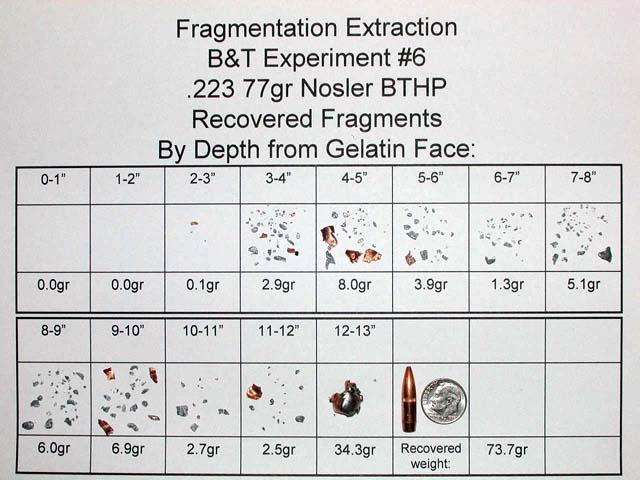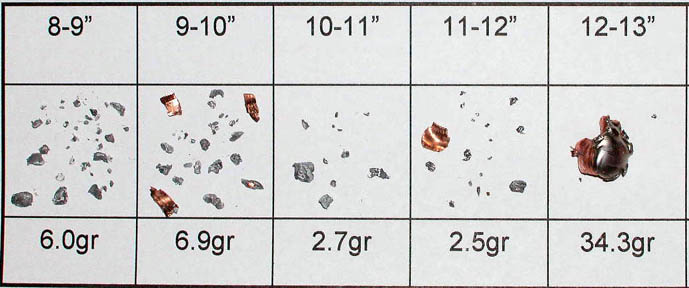
b
& t ammo labs test #6:
Multiple Round, High Velocity (NATO Pressure) 5.56mm 77 grain OTM (Mk262 Mod 1) performance in bare gel.
Multiple Round, High Velocity (NATO Pressure) 5.56mm 77 grain OTM (Mk262 Mod 1) performance in bare gel.
introduction:
B&T Ammo Labs Fragmentation Experiment #6:
"Multiple Round, High Velocity (NATO Pressure) 5.56mm 77 grain OTM (Mk262 Mod 1) performance in bare gel."
Tatjana von E. and Derek W. F.
This experiment was designed to assess the terminal performance and wounding properties of magazine length, NATO pressure, 77 grain, cannelured, "Open Tip Match" rounds (Mk262 Mod 1) in 10% calibrated ballistic gelatin. These 77 grain rounds are samples provided by Black Hills through distributor Georgia Precision and represent trial loadings for the proposed special order group purchase of the ammo from Black Hills and Georgia Precision.
While SAAMI pressure loadings of various 77 grain rounds are available, the more recent use of heavier rounds with shorter barreled carbines in response to inconsistent and less than ideal performance of lighter (sub 65 grain) rounds at range and from carbines prompted us to seek to specify and test a higher pressure, heavy round in order to increase the range of effective terminal performance from 14.5 and 16" carbines. In addition, we prefer a cannelured round for feeding purposes and reliability. Our goal was to provide a demonstrably viable solution for increased terminal performance from short barreled (14.5-18") carbine systems between 0 and 150-300 meters or beyond.
We believe the Mk262 Mod 1 meets and exceeds our expectations in this respect.
As usual, the outstanding support of the AR15.com community makes this experiment possible. In particular we would like to thank "Tommy" from Georgia Precision, for providing us with samples of the round and Black Hills for lending their manufacturing facilities to our collective project.
Also, we would like to thank AR15.com moderator, Troy for his assistance in generating enough interest in the round to make commercial quantities of interest to Black Hills, "Captain K," who, as usual, we cannot say much about, and AR15.com and Maryland AR15 Site official Forest. Who could forget AR15.com member "Hi-Vel" for the molds that continue to serve us well. Of course, as usual we are probably forgetting many people who were instrumental in the many stages of this project. Hopefully they will forgive our omission.
specifics and conditions:
Ammo: .223 77 grain Copper Alloy Jacketed Open Top Match rounds with cannelure.
Nosler bullets loaded to NATO (military) pressure specifications in Winchester
brass by Black Hills as per special order.
Rifle: Preban 16" Colt M4 1:7 upper on a Bushmaster lower.
Temp: 92F
Humidity: 60%
Alt: 215 ASL
The target was a FBI spec block (20x20x50cm) of 10% ballistic gel (9 parts water, 1 part gelatin by weight). Vyse ballistic gel was prepared according to FBI ballistic gel testing protocols. Additionally, gel temperature was not permitted to exceed 37 degrees C at any time during preparation.
Following preparation, gel was stored at ~4 degrees C and permitted to cure for 72 hours before testing. Gel was tested within 15 minutes after removal of blocks from refrigeration. Gel blocks were calibrated with a .177 caliber BB immediately before testing. (Optimum = 8.5cm @ 590 fps). Our results were within accepted calibration standards for ballistic testing without penetration measurement adjustment.
10 velocity tests on each type of round was conducted using
an Oehler Research 35P chronograph 15 feet from the muzzle. Results are
included below:
2738
2725
2735
2730
2757
2712
2719
2741
2729
2744
Mean: 2733 fps.
After some alignment shots, targets (bare gel blocks) were placed 16 feet from the muzzle and each subjected to a single round. Velocity of the projectile was again measured at 15 feet, 1 foot before the gelatin block.
Multiple blocks were shot.
The blocks were examined, photographed and then dissected into slices. Slices were photographed to measure and record wound profile size. Fragments were then extracted and their penetration depth measured and recorded. Fragments were organized according to penetration depth and photographed to record fragment distribution throughout the wound cavity.
The ammunition was consistent in gel with all shots exhibiting similar ballistic performance- only a .5" variation in penetration between all shots was observed.
Results notes/Observations:
Velocity of the displayed gel shot was 2734 fps.
Fragmentation of the rounds was dramatic and among the 3 best rounds tested by the authors.
Total penetration averaged 12.5"
Despite the excellent fragmentation, substantial bullet mass typically was retained in one or two larger lead/copper fragments, which typically established the farthest penetration frontiers in the gel. The authors believe this behavior represents a positive sign for this round's tissue performance after barrier interaction.
Neck length was generally around 1.6".
The largest recovered fragments typically appear to be the bullet's base and rear jacket structures.
Wound cavity size at its extreme was typically 3.875" at inch 4-5 and numerous fragments were deposited at the extreme edges of these fractures, indicating high tissue disruption potential even at the frontiers of the round's tissue disruption.
Comparison to SAAMI pressure 77 grain nosler (no cannelure):
Recovered Weight:
SAAMI 77gr: 74.2gr
NATO 77 gr: 73.7 gr.
Fragmentation:
SAAMI 77gr: 74.2gr.
NATO 77 gr: 73.7 gr.
Largest Recovered Fragment:
SAAMI 77gr: 32.1gr.
NATO 77 gr: 34.2 gr.
Neck:
SAAMI 77gr: 1.57"
NATO 77gr: 1.60"
The NATO pressure 77 grain OTM is a solid and consistent
performer with substantially better fragmentation at close range than
M193, M855 and most sub 68 grain rounds. The NATO pressure round will
provide fragmentation at ranges between 25-75 meters father than the SAAMI
pressure round. The addition of a canellure does not appear to dramatically
alter fragmentation, which is as good or better than that of the SAAMI
pressure round and equals all heavy (65+ grains) rounds tested excepting
the magazine length .223 100 grain OTM round tested by the authors.
Overall gel penetration at the muzzle is lower in the NATO pressure 77 grain round, probably as a result of increased muzzle velocity and the consequent increase in stress the round experiences when passing through tissue simulant. Accordingly, fragmentation is initially more violent and penetration reduced. The authors expect that penetration of the 77 NATO round from a 16" barrel will increase by 2-3" to match the SAAMI penetration (13-14") after travelling between 50 and 70 meters and as velocities reduce. Penetration should then level off near 12.5" until the fragmentation threshold is reached.
Fragmentation of the NATO 77 grain round is more extensive than that of the SAAMI at depths from 7-12 inches. Wound profile at this depth is more extensive as a result.
In summary, the NATO 77 grain OTM round fills an important gap and we believe will substantially increase the terminal performance of 14.5" and 16" civilian weapons systems for practical self defense.
Other notes and observations:
Fragmentation was extensive enough to cause Dr. Brouhaha (hee!) to utter occasional profanities during the extraction process. This is generally a good indicator of high levels of terminal performance.
Ballistic trajectory of the 77 grain round generally yields a 2" rise at 100 meters and a 8.9" drop at 300 meters using an Improved Battlesight Zero (IBZ) and a 16" barrel. This makes the deployment of these rounds very viable for close to medium (0-300 meter) defensive purposes in combat conditions without any necessity for combat sighting adjustment. (A critical criteria for practical rifle use in self-defense).
Preliminary experiments show that reliable fragmentation for the rounds will extend to at least 225 meters in 16" weapons. The authors have additional reason to believe (but insufficient data as of yet to make a supported claim) that reliable fragmentation may, in fact, extend out to 250 meters from a 16" barrel and 220 meters from a 14.5" barrel. Testing in this area continues.
Note: Neither Dr. Tatjana nor Dr. Brouhaha are Doctors of anything, they have, however, stayed at Holiday Inn Expresses.
Special Note from Dr. Tatjana: It is so very good to be back.
figures:

Figure A: Left to right: M193, M196, M855, M856, 77
grain OTM

Figure B: 77 grain OTM rounds in packaging.

Figure C: 77 grain performance in gel (wide view)

Figure D: 77 grain performance in gel (close up of deep fragmentation).

Figure E: Recovered fragments by depth.

Figure F: Recovered fragments by depth (8-13" closeup).



Figure G: Ballistic performance of the 77 grain round (left to right,
77 NATO 14.5", 77 NATO 16", 77 SAAMI 16") (Fragmentation
thresholds in red).


Figure H: Ballistic performance of the 77gr NATO round (16" velocity
and drop, 14.5" velocity and drop)